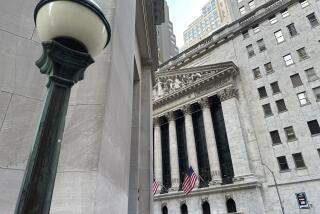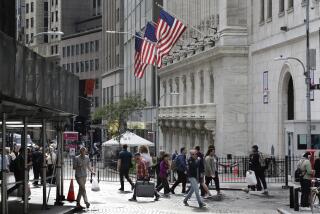Stock and Bond Prices Pull Back : Dow Falls 7.14 Amid New Fears of Rising Interest Rates
NEW YORK — Stock and bond prices pulled back Wednesday, faced with renewed upward pressure on interest rates.
The Dow Jones average of 30 industrials, up 8.48 points Tuesday, fell 7.14 to 1,863.29. At its mid-session low, the average was down about 20 points.
Volume on the New York Stock Exchange came to 116.96 million shares, against 114.71 million on Tuesday.
Interest rates declined briefly at the opening Wednesday but then resumed their recent rise as conjecture spread that the Federal Reserve was reluctant to ease credit further.
The Treasury Department’s bellwether 30-year bond fell nearly $20 for every $1,000 in face value to yield 7.9%, up from 7.8% late Tuesday. Bond prices move in the opposite direction from interest rates.
Many observers now believe that the stock market must draw its inspiration from a fresh source, such as improving corporate profits, if it is going to resume the dramatic rise that it staged from last fall through the first quarter of 1986.
However, the evidence is less than conclusive to date that earnings will pick up enough momentum in the months ahead to stir up widespread enthusiasm for stocks.
Among actively traded blue chips, International Business Machines fell 2 3/4 to 150, American Telephone & Telegraph 1/8 to 24 1/2 and Eastman Kodak to 61.
Energy stocks declined along with oil prices. Amoco lost 1 1/8 to 62 3/4, Exxon 3/4 to 59 5/8, Atlantic Richfield 1 3/8 to 53 3/8, Chevron 5/8 to 40 and Mobil 1/2 to 30 7/8.
Commonwealth Edison dropped 7/8 to 30. The company said it had shut down a unit at its LaSalle nuclear power plant after a malfunction Sunday, adding that no release of radiation occurred.
Auto issues declined as domestic car makers reported lower sales for the last part of May. General Motors fell 7/8 to 78, Ford Motor 5/8 to 53 5/8 and Chrysler 3/8 to 36.
Bank stocks also were weak, with J. P. Morgan down 1 3/8 to 85 5/8, Citicorp 7/8 to 60, Chase Manhattan 5/8 to 42 1/8 and Chemical New York 1/8 to 52 1/2.
In the overall tally on the Big Board, about nine issues declined in price for every five that gained ground.
Block Trades Inch Up
Nationwide turnover in NYSE-listed issues, including trades in those stocks on regional exchanges and in the over-the-counter market, totaled 138.43 million shares.
Large blocks of 10,000 or more shares traded on the NYSE totaled 2,131, compared to 2,027 on Tuesday.
Standard & Poor’s index of 400 industrials fell 1.80 to 273.20, and S&P;’s 500-stock composite index was down 1.57 at 243.94.
In the secondary market for Treasury bonds, prices of short-term governments fell 9/32 points, intermediate maturities fell 26/32 points and long-term issues were down 1 6/32 points, according to the investment firm of Salomon Bros.
Analysts cited a number of factors to explain the day’s decline.
“A lot of it was a lot more rumor than reality,” said Charles F. Eaton III, an analyst at the Portsmouth, N.H., office of Nesbitt Thompson Securities.
He said the market was unnerved by reports that Fed Chairman Paul A. Volcker, attending a meeting of central bank officials of major industrial countries in Boston, had made “comments to the effect that interest rates had gone low enough” both Tuesday and Wednesday.
This came after the market had already been “stunned” by indications that “someone had sold $1 billion in bonds” in early trading, he said.
“They did it as the bond market was rising. It hit the market and the market went right down from there,” Eaton said.
The Merrill Lynch daily Treasury index, which measures price movements on all outstanding Treasury issues with maturities of a year or longer, fell 0.92 to 113.08. The Shearson Lehman daily Treasury bond index, which makes a similar measurement, fell 5.41 to 1,187.86.
In corporate trading, industrials and utilities both fell 1 1/2 points in moderate trading.
Among tax-exempt municipal bonds, general obligations fell one point and revenue bonds were down one point. Trading was moderate.
Yields on three-month Treasury bills were up 14 basis points to 6.53%. Six-month bills rose 11 basis points to 6.56%. One-year bills were up eight basis points to 6.61%. A basis point is one-hundredth of a percentage point.
More to Read
Inside the business of entertainment
The Wide Shot brings you news, analysis and insights on everything from streaming wars to production — and what it all means for the future.
You may occasionally receive promotional content from the Los Angeles Times.










